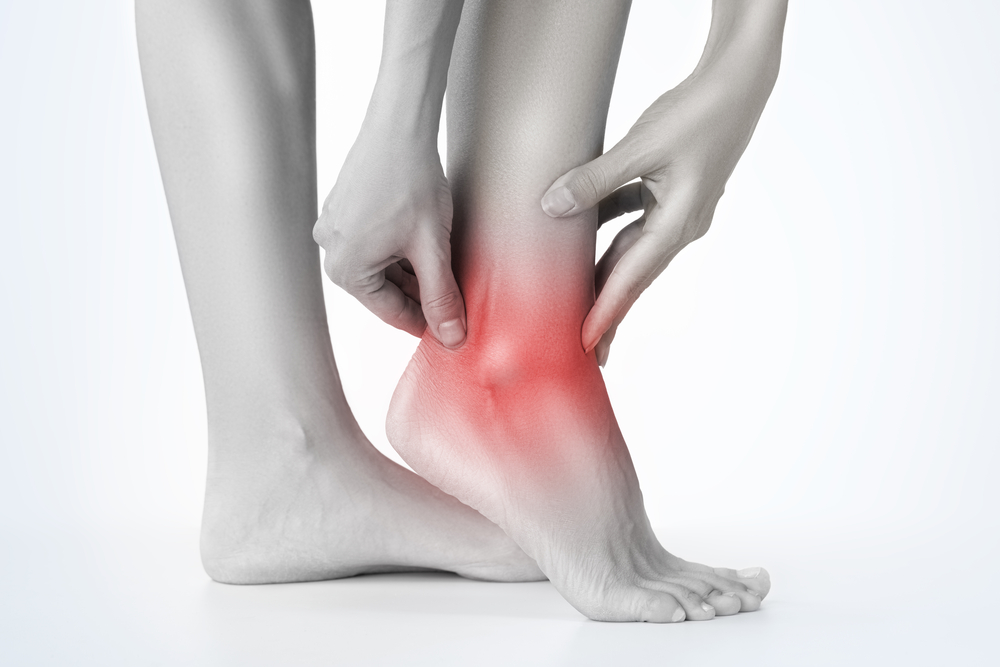
Each of your feet contains 26 bones that form 33 joints, including the largest one in the region, your ankle. Together, these feet/ankle bones account for more than one-quarter of the 206 bones in your body.
The bones in your feet are supported by more than 100 soft tissue structures, including tendons, ligaments, and muscles. As you can imagine, with those components working together every day, allowing us to be ambulatory, it only takes an injury to one of those structures to throw your gait entirely off course.
The Humble But Mighty Ankle
Each ankle joint consists of three bones, the talus, a triangular-shaped bone beneath the tibia and fibula; the calcaneus, or heel bone; and the navicular bone on top of the talus. All three bones are connected to the fibula and tibia bones of the lower leg.
Your ankle is a hinge joint meaning it moves in one direction—up and down rather than side to side. This allows you to propel yourself forward when walking or running.
The ankles are super strong. On average, the human ankle can support up to five times your body weight, allowing it to absorb and disperse the shock of your movements.
Ankle Sprains Happen in a Flash
Most people will experience a tweaked, twisted, rolled, or sprained ankle at least once in their lives. Unsurprisingly, ankle sprains account for nearly 2 million injuries yearly and 20 percent of all sports injuries in the U.S.
Ankle sprains can occur when ligaments around the ankle joint stretch too far or tear. These sprains can happen due to a sudden twist, force, or misstep.
A broken ankle can range from small hairline or stress fractures to traumatic bone breaks. Typical causes of ankle fractures are experiencing too much force (ex: jumping and landing hard or awkwardly), blunt force (ex: car accident or during a sport), falling/slipping, over flexing, or overextending the joint.
Women are 4x more likely than men to experience foot/ankle pain. This is likely due to footwear fashion choices such as wearing high heels or boots that put significant stress, force, and potential torque on the ankle joint.
Symptoms of Ankle Woes
You can do significant (and sometimes permanent) damage if you walk around on an untreated ankle sprain or fracture. If you have any of the following symptoms in your foot/ankle region, see your physician as soon as possible.
- Difficulty bearing weight or walking
- Throbbing/aching sensation
- Bruising
- Redness/tenderness
- Sharp pain
- Swelling
- A deformity in the foot/ankle area
- Increased pain during activity and decreased pain during rest
Treatments for An Ankle Issue
If you find yourself with a mild to moderate ankle sprain, there are some self-care modalities that can assist in promoting healing.
- R.I.C.E is the acronym for Rest, Ice, Compression, and Elevation.
- Rest: Stop weight-bearing activity as much as possible to protect it from further damage.
- Ice: Apply an ice pack to reduce pain and swelling for between 10 and 20 minutes at a time, a few times a day. Do this for the first two to three days. Protect your skin with a towel or other cloth.
- Compression: Wrap the injured area with an elastic ankle sleeve or brace or wrap. Loosen the bandage if you notice numbness, tingling, increased pain, or swelling below the wrap. Using RockTape is another recommended option that we sell at Vaida.
- Elevation: Raise the injured part to or above heart level anytime you are sitting or lying down.
2. Do the Ankle Alphabet.
Once your ankle has had some time to heal and you are pain-free, it is time to strengthen or restrengthen its supporting structures. The stretching and strengthening movements in the “ankle alphabet” will help build foot and ankle strength, which can aid in its future stability.
If you have experienced a major sprain or fracture, please follow the advice of your physician or orthopedist.
How Chiropractic Care Can Help Our Patients With Achy Ankles
Our feet are the grounding foundation of our anatomy and maintaining a balanced alignment of foot + ankle joints is essential for maintaining balance for/in our entire body.
If you start compensating or guarding due to pain, inflammation, or imbalance in the ankle/foot area, that compensation pattern will also move through your body and eventually cause compensation and misalignment in the head, neck, and shoulders.
Regular chiropractic adjustments with Dr. Lydia and Dr. Bethanie can help restore balance, mitigate or alleviate pain and improve healing time.
If you have recently found yourself with an ankle issue and you have been limping along, don’t wait until everything else hurts, schedule an appointment at Vaida and give your body the reset it needs; it will thank you.
*Disclosure: As an Amazon Associate, Vaida earns a small commission from qualifying purchases on some products listed in our content.
